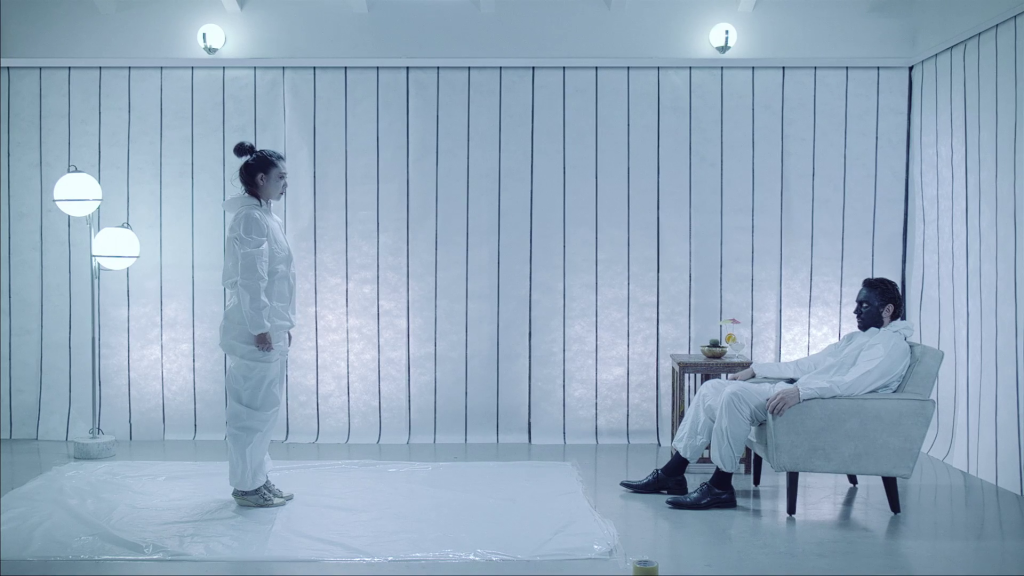Introduction
Ran Slavin, a cross media audio-visual artist from Tel Aviv, has been experimenting with cinema, digital and acoustic music, video art and live video/sound performances for many years. Can his visual work, which has been described as an intense urban surrealism, also be utilized to craft a visual deliciously and thematically engaging feature film? Let’s find out.
Review
Call For Dreams is – and this is meant as a compliment – a strange but artful narrative. While Slavin’s narrative appears, at first glance, a film that offers style over substance, there is certain subtle depth that underpins the unfolding of his narrative.
The stylish aspect of Call for Dreams is function of a fluid blend between elements of sense and elements of nonsense. It is especially via the seemingly non-sensical elements that Slavin succeeds in giving his film a stylish and artful flavour. Luckily, what appears non-sensical at first in Call for Dreams eventually receives a sufficient explanation, i.e. the explanation of a parallel multi-dimensional reality. But this explanation does not resolve everything – nor does it need to. The sci-fi element gives the film its necessary consistency, a certain reason for the artful visual escapades, but without being able to dazzle us with its inventiveness, without giving the unfolding of the narrative the power to blow our mind at a thematical level.
The artful elements of non-sense also play an important role in infusing a certain estranging sense of mystery into Call of Dreams. The sensibility of this estranging mystery additionally depends on the narrative’s atmosphere, which is mainly function of the colour/lightning design and the subtle musical accompaniment.
Is there is anything that stands out in Slavin’s composition is its exquisite colour-design. The opening of Call of Dreams, for instance, gives the spectator a flavour of the colourfulness of the Tokyo’s gambling nightlife. Yet, this enticing bombardment of nightlife colours emphasizes, by contrast, the emotional emptiness of those who gamble and the repetitiveness they fell victim to. Even though the signifier ‘dreams’ is richly referenced in this night-life space, these subjects are, in truth, imprisoned within a colourful and flashy nightmare.
The contrasting colourfulness underlines the lack of emotional expressions and the lack of purpose that marks the comportments of those in the pachinko scene, i.e. the subjective emptiness is thus first and foremost function of the acting-performances. Yet, the subjective emptiness is also directly echoed via the colour-design as such. Whenever Eko (Mami Shimazaki) moves within her personal space, she is surrounded by a darkish and blueish atmosphere. The noisy colourful atmosphere she escapes to cannot resolve the dark emptiness that marks her as subject. In truth, her flight into the dazzling superficial colours of gambling is the very reason why she, as subject, is devoid from any desire or dreams, from something that would give her life meaning and direction.
It is the confrontation with this senseless repetition and her very own emptiness that leads Eko to publish an ad in the newspaper that calls for dreams. She starts searching for the dreams for others not only to fulfill the desires of others, to let the desire of the other animate her, but in the hope of utilizing this desiring other, utilizing the Other’s desire in the hope of finding a desire for herself (Narra-note 1).
What kind of desires does Eko meet? All desires she meets are Thanatos desires – desires to destroy the other, desires to destroy oneself. These desires underlines, albeit in a rather indirect way, that the subject feels at odd with his societal environment, with the Other he, as subject, is subjected to. These kinds of desires are, furthermore, not the kind of desires that animate the subject, that infuse a certain sense into his being. No, these desires are focused on murdering the eros drive, on robbing a body of the life force that drives it.
Yet, by structuring his narrative around these strange desires and the mystery that surrounds them, Slavin reveals that the true unconscious desire is destructive in nature, that every desire is marked by a seed of Thanatos. Desires of dreams revolve around aggression, be it subtle – social aggression – or be it explicit – physical aggression.
Beyond using colour to evoke Eko’s subjective truth, Slavin also utilizes, in a rather exquisite way, the colour and lightning-design for compositional purposes. The dimension of light and colour is not only used to give certain shots and sequences a pleasing geometrical composition, but also to emphasize the abstract geometry of certain sets, to elevate the visual pleasure and the artful feel of certain sequences by stylizing, via a play with colour, the narrative space.
Call For Dreams is, first and foremost, a visual experience. Luckily, Slavin’s narrative is not only style, a simple concatenation of artful and visually pleasing sequences. There is a certain thematical depth to Call of Dreams – underlining, for instance, the destructive element that marks human desire. Yet, this thematical depth cannot hide the fact that the structure of the narrative is mainly in function of the visuals, that the vague mysterious narrative mainly aims to justify the artful visual sequences. A more tight and developed narrative would not only have made the narrative much more engaging but would also made the visual artfulness even more impactful.
Notes
Narra-note 1: In fact, Slavin never gives a definite explanation to why Eko publishes her ad in the newspaper. Our reading of this act is function of what happened before, i.e. her collapse at the pachinko place.





